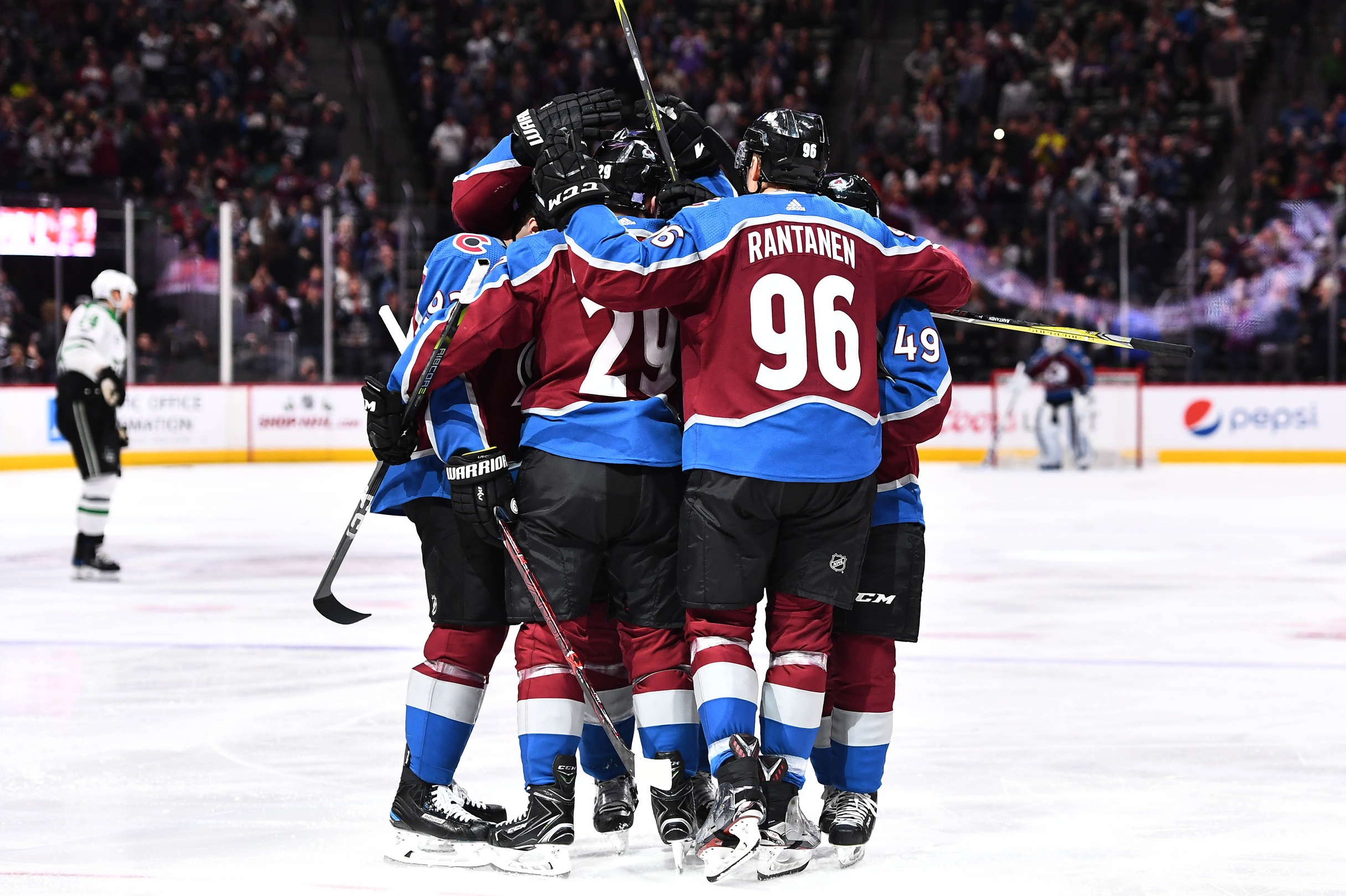Perhaps Avalanche defenseman Erik Johnson, pictured above in 2016 with his 2-year-old colt Crosscheck Carlos at Del Mar, could name the next racing thoroughbred yearling he buys “Minutes Eater.”
After the Avalanche’s 3-0 win over Dallas at home Wednesday night, Johnson was averaging 26:32 of ice time. That was fifth highest in the NHL, behind only fellow defensemen Rasmus Ristolainen of Buffalo (27:10 in only 13 games), Ryan Suter of Minnesota (27:06), Drew Doughty of Los Angeles (26:59) and John Carlson of Washington (26:57).
That’s not a quantum leap for Johnson, whose highest average in a full season with Colorado is the 24:25 he posted in 2014-15, Patrick Roy’s second of three seasons behind the bench. But it’s more than in the past.
Last season, when he was out of the lineup for 12 weeks with a broken fibula, he averaged 22:05.

Erik Johnson is in there somewhere as his teammates surround him and celebrate his second-period goal against Dallas Wednesday night. Ron Chenoy-USA TODAY Sports
The eye-test standard supports the conclusion that he has been playing well this season against opposing top lines with a revolving cast of defensive partners. Yet he didn’t have a goal until he scored in the stirring overtime win at Detroit Sunday and came right back with his second against the Stars. Through 20 games, he has the two goals and seven assists and is a plus-7.
In the remaking of this team, including the departures of veteran defensemen Francois Beauchemin and Fedor Tyutin, this is one constant: Johnson was, and still is, the Avalanche’s best on the blue line. Now, though, at 29, he also is the oldest.
Even as Beauchemin’s odometer rolled over, he was one of the most respected men in the dressing room — and everywhere else. Colorado bought him out, though, opening a roster spot while providing no cap relief.
Now with that young(er) group around him, including his recent usual partner at full strength of late, 19-year-old Samuel Girard, Johnson is being counted on to not only take on more minutes, but also additional leadership responsibility. He and Nathan MacKinnon are Gabe Landeskog’s assistant captains.

Stars defenseman Stephen Johns (28) checks Erik Johnson (6) in the first period. Ron Chenoy-USA TODAY Sports
After he played “only” 22:51 against the Stars, Johnson joked about it being a light workload — relatively speaking.
I asked him if he was going to go ride the exercise bike for two hours to compensate.
“Yeah, make up for the lost minutes, I guess,” he said.
The two goals in two games match his goal total in 46 games last season. And he said he wasn’t sweating that he didn’t have a goal this season until Sunday.
“I think maybe when I was a little but younger, I’d get down on myself,” he said. “But I knew how well I was playing. I think I was leading the team in shots, so I knew it was going to come. Just stick with it and stay confident in your game, and I think it eventually goes in and now it’s starting to.”
In the long run, the Avalanche will need significant offensive production from him — perhaps his fourth double-digit season in goals — to improve its chances of hanging in as a playoff spot contender and erasing (or at least lessening) the stench of the 48-point embarrassment of 2016-17.
The additional minutes have come from more duty on the penalty kill and on 5-on-5, so it comes down to playing in virtually every situation and with the other five defensemen at various points on some nights.
Can he play 26 minutes a night all season?
“I don’t know,” Johnson said with a smile after the morning skate. “I’ve never done it before. We’ll find out. I’m definitely on pace for it. I think I can. I feel good. You never know until you try it. I notice it,” he added of his increased ice time, “but I feel like I’m recovering quick and my legs feel good and my lungs feel good, and there are no ill effects from it so far. I feel great.
“I feel like the added responsibility has elevated my game a little bit.”
The trick, of course, is to avoid diminishing returns. It’s another litmus test of whether Johnson — the NHL’s No. 1 overall draft choice in 2006 who came to Colorado from St. Louis in a February 2011 trade — not only can play NHL elite defenseman minutes, but break through to that status night in and night out.
Johnson doesn’t play the game of false modesty when asked about that. He believes he’s there.
“I think so,” he said. “I don’t think you play those types of minutes unless you’re seen in that light, not only from other people, but definitely the organization. You’re not put out there in those situations unless they see you crossing into that plane and for me, maybe it’s taken a little bit longer than I had anticipated. I’m kind of an impatient guy, I wanted things to happen right away.
“Over the course of the first six, seven years, it happened slower than I would have liked, but I love where my game’s at. I’m not satisfied, I’m not content, you have to always work and evolve and get better because all these kids who come in are so fast and so good and so young, you have to constantly adapt and change.”
I asked Avalanche coach Jared Bednar if he was going to try to shave a bit off Johnson’s ice time.
“Nope, we can play him that all year,” Bednar said. “He’s handling it great. He’s in phenomenal condition. He’s a bit of a thoroughbred” — that was a bit of an inside joke, of course — “and always has been. For me, if his game slips, then we’ll start thinking about his minutes, is it too much. We’re going to monitor it. We talk to him a lot. If he needs a rest day or to take a practice off, then we’ll give it to him. Games are the most important thing.
“If you look around the league at the top guys on other teams, they play that all the time. I know he’s in the league leaders, or amongst them, but those guys are all top minute D-men that play in the first pair.”
The picture changed, though, when the Avalanche acquired Girard from Nashville in the Matt Duchene trade, installed him in the lineup and then committed to keep him on the NHL roster and trigger his three-year entry level deal, rather than return him to Chicoutimi of the Quebec Major Junior Hockey League for more seasoning.
Now in Girard and Tyson Barrie, the Avalanche has two puck-moving and undersized defensemen in its top six.
Johnson said of playing with virtually all the other Avalanche defensemen: “I know all these guys pretty well. ‘G’s’ been pretty fun to play with and we’re in and out of our own zone quick and we’re making things happen in the offensive end. I see some shifts with other guys 5-on-5 to play against the top line, but I’ve really seen everybody this year. So it’s fun. It keeps you on your toes, kind of thinking who you’re going out with every time, so you have to be sharp. . .
“G is a similar player to Tyson. They both make good plays with the puck. G’s been really good coming back into his own zone and making breakout plays by himself. He’s small, but he doesn’t seem to get hit a lot. . . When he’s got the puck or we’re looking to make a breakout, he’s been there. The biggest thing you find with the young guys is if they’re scared to talk out there because you don’t want to say the wrong thing. But he’s been talking to me. I’m trying to talk to him and make him feel as comfortable as possible. But he’s light years ahead of any defenseman than breaks into the league right away.”
In his spare time, Johnson continues to monitor his horse-racing ownership interests. As ERJ Racing, he is in partnerships with some of thoroughbred racing’s heavy hitters.
“It’s so easy with the apps nowadays, you can just plug your horse into your virtual stable and then you get notifications on your phone,” he said. “Like if they work out or when they run. It takes no effort at all, just pick up the phone and look at it and it takes a minute and a half to watch the race.”
By the way, Crosscheck Carlos earned $136,453 in eight career starts, with two firsts and four seconds, before he was retired earlier this year because of injury.
Here’s the page on Equibase.com that lists ERJ Racing’s various partnerships.
Erik Johnson’s average ice time through the years
2007-08 St. Louis 18:11
2008-09 St. Louis (injured, did not play)
2009-10 St. Louis 21:27
2010-11 St. Louis 22:08
2010-11 Colorado 24:33
2011-12 Colorado 20:50
2012-13 Colorado 20:45
2013-14 Colorado 23:00
2014-15 Colorado 24:25
2015-16 Colorado 23:27
2016-17 Colorado 22:05
* * *
Denver-based journalist Terry Frei writes two commentaries a week about the Avalanche for Mile High Sports. He has been named a state’s sports writer of the year seven times, four times in Colorado (including for 2016) and three times in Oregon. He’s the author of seven books, including the fact-based novel “Olympic Affair” about Colorado’s Glenn Morris, the 1936 Olympic decathlon champion; and “Third Down and a War to Go,” about the 1942 football national champion Wisconsin Badgers and the players’ subsequent World War II heroism. His web site is terryfrei.com and his additional “On the Colorado Scene” commentaries are at terryfrei/oncolorado.
E-mail: [email protected]
Twitter: @tfrei
MHS Commentary Archive:
Ring of Famer Red Miller, Part One: Coal Miner’s son
Ring of Famer Red Miller, Part Two: About those %$#@ Raiders…
This time a year ago, the wheels fell off
Post-trade: On Girard and Kamenev
Stockholm is a Homecoming for Landeskog
Why Can’t MacKinnon do that every night?
At the Pepsi Center, you’ll think you’re in Chicago
Is Zadorov ready to be – and stay – a top-pairing “D”?
For this is to work, Bernier has to be better
This isn’t just Jared Bednar’s second season. It’s his second chance.
Sven (The Reindeer) Andrighetto speedily skating into Avalanche forefront
With Avalanche off to another 3-1 start, leadership is a “core” issue



